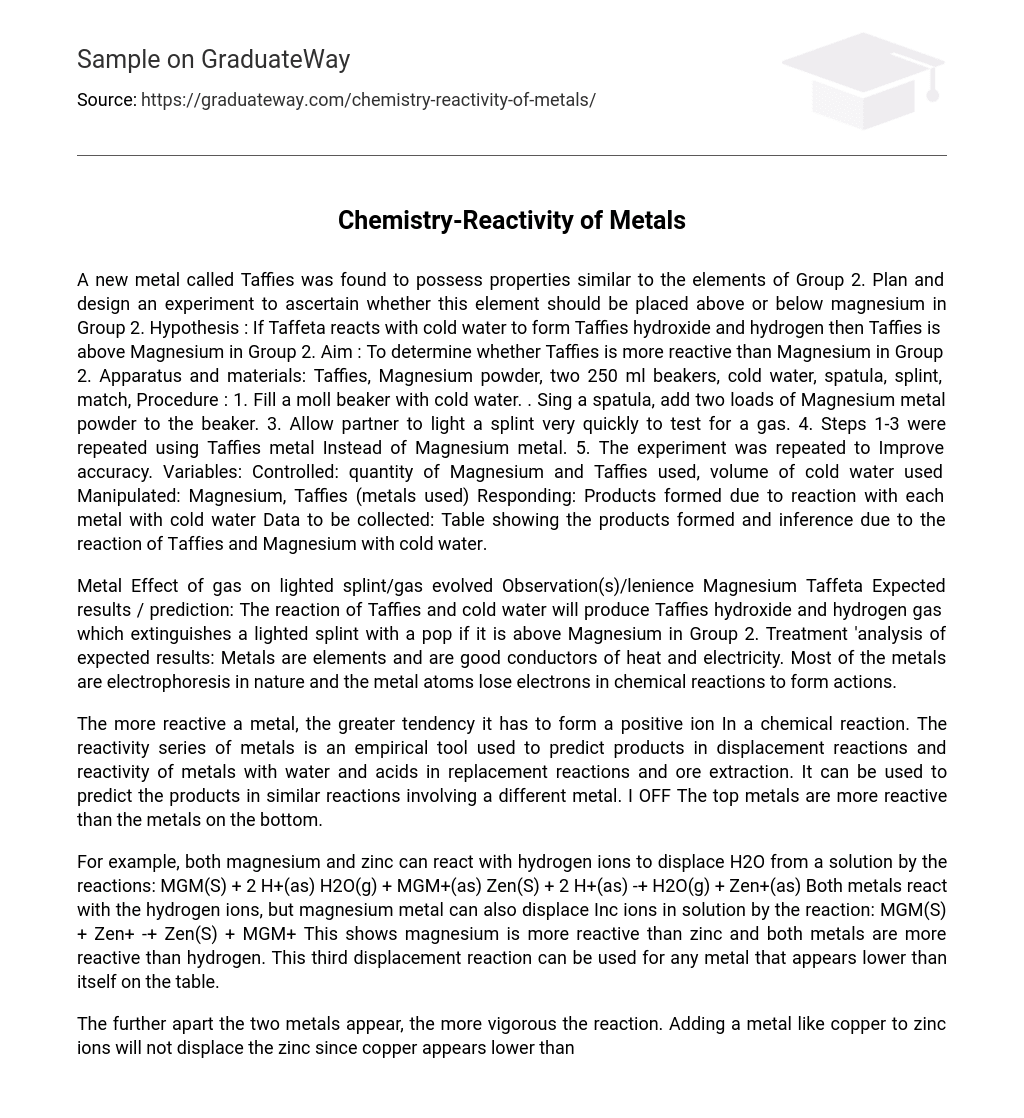A new metal called Taffies was found to possess properties similar to the elements of Group 2. Plan and design an experiment to ascertain whether this element should be placed above or below magnesium in Group 2. Hypothesis : If Taffeta reacts with cold water to form Taffies hydroxide and hydrogen then Taffies is above Magnesium in Group 2. Aim : To determine whether Taffies is more reactive than Magnesium in Group 2. Apparatus and materials: Taffies, Magnesium powder, two 250 ml beakers, cold water, spatula, splint, match, Procedure : 1. Fill a moll beaker with cold water. . Sing a spatula, add two loads of Magnesium metal powder to the beaker. 3. Allow partner to light a splint very quickly to test for a gas. 4. Steps 1-3 were repeated using Taffies metal Instead of Magnesium metal. 5. The experiment was repeated to Improve accuracy. Variables: Controlled: quantity of Magnesium and Taffies used, volume of cold water used Manipulated: Magnesium, Taffies (metals used) Responding: Products formed due to reaction with each metal with cold water Data to be collected: Table showing the products formed and inference due to the reaction of Taffies and Magnesium with cold water.
Metal Effect of gas on lighted splint/gas evolved Observation(s)/lenience Magnesium Taffeta Expected results / prediction: The reaction of Taffies and cold water will produce Taffies hydroxide and hydrogen gas which extinguishes a lighted splint with a pop if it is above Magnesium in Group 2. Treatment ‘analysis of expected results: Metals are elements and are good conductors of heat and electricity. Most of the metals are electrophoresis in nature and the metal atoms lose electrons in chemical reactions to form actions.
The more reactive a metal, the greater tendency it has to form a positive ion In a chemical reaction. The reactivity series of metals is an empirical tool used to predict products in displacement reactions and reactivity of metals with water and acids in replacement reactions and ore extraction. It can be used to predict the products in similar reactions involving a different metal. I OFF The top metals are more reactive than the metals on the bottom.
For example, both magnesium and zinc can react with hydrogen ions to displace H2O from a solution by the reactions: MGM(S) + 2 H+(as) H2O(g) + MGM+(as) Zen(S) + 2 H+(as) -+ H2O(g) + Zen+(as) Both metals react with the hydrogen ions, but magnesium metal can also displace Inc ions in solution by the reaction: MGM(S) + Zen+ -+ Zen(S) + MGM+ This shows magnesium is more reactive than zinc and both metals are more reactive than hydrogen. This third displacement reaction can be used for any metal that appears lower than itself on the table.
The further apart the two metals appear, the more vigorous the reaction. Adding a metal like copper to zinc ions will not displace the zinc since copper appears lower than zinc on the table. The first five elements are highly reactive metals that will react with cold water, hot water, and steam to form hydrogen gas and hydroxides. The next four metals (magnesium through chromium) are active metals that will react with hot water or steam to form their oxides and hydrogen gas. All the oxides of these two groups of metals will resist reduction by H2O gas.
The six metals from iron to lead will replace hydrogen from hydrochloric, sulfuric and nitric acids. Their oxides can be reduced by heating with hydrogen gas, carbon and carbon monoxide. All the metals from lithium to copper will combine readily with oxygen to form their oxides. The last five metals are found free in nature with little oxides. Their oxides arm through alternate pathways and will readily decompose with heat. The group 2 elements in the periodic table are called alkaline earth metals.
Alkaline earth metals are beryllium (Be), magnesium (MGM) calcium (Ca), strontium (Sir), barium (Baa) and radium (Ra). The groups and group 2 elements are together called s-block elements. This series chart works remarkably well for reactions that occur at or near room temperatures and in aqueous solutions. Limitations: residue of other materials in the beaker from previous experiments which possess the ability of reacting with the water in the beaker to produce a gas which may be Estes for using a lighted splint. Precautions: a.
Ensure that the experiments are carried out quickly so as to prevent the cold water in the beaker from becoming very warm. B. Ensure to light the splint before or during the metal is being added to the beaker containing cold water so as to test for the gas evolved before it escapes from the atmosphere of the beaker. Assumptions: The volume of water used was sufficient to completely react with the two spatula loads of each metal used if there is any reaction. A. The gas produced, if any, was due to a reaction of the water and metal used in each of the two experiments.





